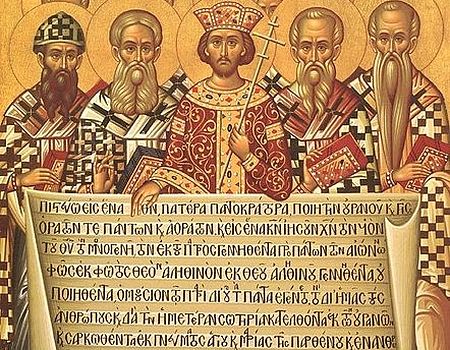Paul of Samosata is Bishop of Antioch, where he holds the public office of Procurator ducenarius, and has the unreserved support and patronage of Queen Zenobia of Palmyra. In 267, Zenobia’s husband Odenat and his eldest son died, and nominally the rule over the Palmyrians and the titles of great “King of Kings” and corrector totius orientis passed to his younger son Vabalat, but he actually ruled his widow. The educated ruler of Palmyra is tolerant, against any persecution, protector of Christians, unlike the Roman Empire, which is a systematic persecutor of Christianity.
After the reign of Emperor Gallian (253-258) and the short reign of Emperor Claudius II the Gothic, he headed Rome for approx. two months in 270, Quintil, who was the brother of Emperor Claudius II and semi-legally assumed power after his death. The Senate recognizes Quintil, but not the strong Danube Army, which sympathizes with its commander Aurelian, a brilliant military genius who repeatedly defeated the Palmyrian troops. The empire grew after 267 all the way to Antioch. After the final Roman victory, Zenobia became part of the spoils, shown in the triumph of Emperor Aurelian in Rome in 272, Bishop Paul, because of his close relationship with the defeated queen of Palmyra, as a kind of her agent in Antioch, is a suspicious person for the emperor and the new ruler of Rome. This may have been used very strategically by his ecclesiastical opponents, sending a letter to the emperor to resolve the intra-Christian dispute by removing the conciliar convict bishop of Antioch, who is known for his loyalty to the Roman enemy Zenobia. The idea of an imperial church was born quite naturally, because the Christian figures of the era were not deprived of political consciousness. The first information about the idea of an imperial church, according to Prot. N. Afanasiev, can be traced back to the III century, just when the Council of Antioch of 268 on the case of the Bishop of Antioch Paul of Samosata wrote a message to all the bishops of the ecumenism (the entire known world), οἰκουμένη.
Paul’s teachings and dogmatic deviations were considered at several councils between 264 and 266, the first of which St. Dionysius of Rome wanted to take part in, but was hindered by his infirmities. Bishop Firmilian of Caesarea, St. Gregory the Wonderworker, his brother Atinodorus and many others participated. Being a very rich man, many of his neighboring bishops became his friends and followers. Many also supported his doctrine, which he insisted was Orthodox. At the first synodal meetings, the majority defended his teachings and he was declared Orthodox. At another council he was convicted, but promised to correct his mistakes, which he did not do. Another council was convened in 268-269, on the way for which Bishop Firmilian died. The moderator and accuser of this Council of Antioch was the Antiochian presbyter Malchion, who, in addition to being highly educated, was also the head of the Greek-speaking school of Antioch. In his dispute with Bishop Paul, he succeeded in exposing him as a heretic and in effecting his removal from the episcopal chair. He is also the author of the message that the council addressed to Pope Dionysius of Rome, Maximus, Bishop of Alexandria and the rest of the Ecumenical Episcopate and Clergy, partly preserved by Eusebius, Bishop of Caesarea. In this epistle, Paul is accused of illicit enrichment, arrogance and sanctification, erecting a high pulpit in the temple, and insulting those who do not applaud and greet him with handkerchiefs, and the like. Separately, his scandalous behavior, accepting a woman to live in his home and allowing the same to his clergy. The controversial Archbishop of Antioch, even condemned by the ecclesiastical synod, was unable to be removed from the chair until the conquest of Antioch by Emperor Aurelian in 272, and even then refused to vacate the episcopal residence. A complaint was sent to the pagan Roman autocrat, who rightly ruled (according to Eusebius) that the house belonged to those recognized by the Italian bishops and the city of Rome – apparently this was the main argument before him that the question of legitimacy was based. of the fact of communion with the Roman Church. Bishop Paul was forcibly and humiliated by the secular authorities, after which nothing more is known about his identity. But his legacy and followers did not disappear definitively once the Council of Nicaea found it necessary to establish that the baptism performed by the Paulists was considered invalid. It is separately connected with the dogmatic statements of St. Lucian and Arius, who are also Antiochians.
His teachings are close to the dynamic monarchy of Theodotus, but he is also called a follower of Artemon or Artemis, leader of an anti-Trinitarian sect in Rome in the third century. only man, falsifying Scripture and abusing Tradition to prove his mistakes. Both ancient Christian historians cite refutations of this heresy: Bishop Eusebius of Caesarea speaks of an unnamed work, and Theodoret of Cyrus quotes a title, The Little Labyrinth, a book originally attributed to the Roman priest Caius and more recently. time – of Hippolytus, the supposed and most probable author of the work Philosophoumena.
He manifested through the Old Testament prophets, especially in Moses, but he was most active in the Son of David, born of the Holy Spirit by a Virgin. Christ, the Savior, is human in nature, but St. A spirit inspires him from above. The Father and the Son are one God, although Christ is from the earth with his own personal characteristics. Therefore, there are two Persons in Christ. The Logos as Wisdom dwells in the person Jesus, as we live in our homes, and acts in Him as inspiration, teaches Him, and abides with Him, united to Him not in essence but in quality. So Mary did not give birth to the Word, because she did not exist above all created, but an ordinary person like us. It seems that Bishop Paul of Samosata accepted the conception of Jesus through St. Spirit, saying, “Mary did not give birth to the Logos, because she did not exist eternally, but gave birth to a man like us.” But he never speaks of an earthly father of the Savior, and it is very likely that he accepted the blameless conception, because the authority of the double gospel testimony of Matthew and Mark is an indisputable miracle for him. He composed many church hymns, considering the hymns to be an important part of the worship service, but in them he avoided any hint of the deity of Jesus Christ. “The man Jesus is the Christ-Anointed (Messiah) of God, who appeared in the fulfillment of time, doing the will of God, and thus (apparently in progressive moral development) becomes God.”
The union of two Persons is possible only by mutual consent of the two wills, expressed in the unity of actions and arising from love. Through the immutability of His will, He is like God and united with Him, remaining free from sin. Through His sufferings He overcomes the sin of our firstborn and is joined to God, becoming one with Him in intention and action. God works miracles in Him to prove that He is the Redeemer and Savior of mankind. Through an ever-growing and unceasing friendship, He combines Himself with God in such a way that He can never be separated from Him forever, and His name is above every name as a reward for love. He can be called “God of the Virgin”, “God of Nazareth”. It exists eternally, but only in the sense of predestination.
St. In his Interpretation of the Gospel of Matthew, John Chrysostom criticizes the Jews for not fully understanding the goods that belonged to them, so that those who came from Persia were ahead of those living in Jerusalem, while refuting the teachings of Marcion and Paul of Samosata. The first, Marcion, teaches that Jesus Christ is the son of the supreme and good God and that he has not real but apparent human nature, and the second that Christ is not God but an ordinary man: “The star, approaching, stood above the very head (of the child), thus pointing to His divine origin. And when she stopped, she brought for worship not simple Gentiles, but the wisest of them. Do you see that the star appeared in vain? The sages, even after hearing the prophecy and hearing its clarification from the chief priests and scribes, were still attentive to it. Let Marcion be ashamed, let Paul of Samosata be ashamed, who did not want to see what the sages saw – the leaders of the Church (I am not ashamed to call them such). Let Marcion be ashamed to see them worshiping God in the flesh. Let Paul of Samosata be ashamed to see how Christ is worshiped not just as a man. Although diapers and mangers show that the sages worship the incarnate, they still do not worship the common man.”
The baptism of Christ is understood by the heretical bishop Paul of Antioch as a step towards its union with the Logos. And if Jesus Christ would be God by nature, then there will be two Gods, which is why Paul of Samosata forbids chants to Christ and openly rejects the ancient (mostly Alexandrian) interpretations of the Holy Scriptures.
The Council of Antioch condemns not only the personality and teachings of Paul of Samosata with the term “ὁμοούσιος” he uses, but in the wrong sense in which he uses it – not because he understands the unity of the Hypostasis in the Trinity (as Hilary believes), but because he it means that from a common essence, substance, originates the Father and the Son, or it is divided between the two (as understood by St. Basil and St. Athanasius. The concept of “oneness” was rejected by the conciliar fathers in 268-9). , “In order to refute Pavel Samosatsky’s unitarian conception of God, apparently under the influence of Origen, the conciliar fathers determined with the help of the word” ουσία “(essence) that the Word has a definite personal existence.”
In the fourth century, the Nicene doctrine met with strong opposition, precisely because of this newly introduced Nicene term in the Creed, which had already been rejected by a council in Antioch. In Search of Christian Unity, William Rush sheds light on the path to theological dialogue in the living faith of divided Christian communities in antiquity and interprets it in relation to the modern ecumenical movement, emphasizing overcoming division by consensus of all universal Christianity with basic help. and the action of St. Spirit, which is manifested in the conciliar church activity.
As an illustration, he uses the approach of the Council of Nicaea of 325 to the actions of the Council of Antioch of 268, held 57 years earlier. The Nicaean Fathers in connection with the inclusion of the term “one in the Symbol of Faith” God-Son and God-Father, strongly defend the decisions of Antioch in connection with the anathema of the Bishop of Antioch Paul (Samosatski) and his use again to clarify the relationship between the Son and the Father ὁμοούσιος.
This act of the Council Fathers reveals how the continuity between the pre-Nicene local church councils was understood less as a legal principle than as a spiritual and theological process of reaffirmation and complementarity. On the other hand, the First Council of Nicaea is a model for the new type of reception that was imposed in the fourth century – its decisions were generally accepted only after 56 years of disputes, scandals and disputes marked by dozens of councils and counter-councils, anathemas, imperial interventions and violence.












